Advertisement |
 |
Do you have a career question?
The Naturejobs podcast features one-on-one Q&As, panel discussions and other exclusive content to help scientists with their careers. Hosted on the Naturejobs blog, the podcast is also available on iTunes and Soundcloud.
Listen today! |  | |
 |
 |
TABLE OF CONTENTS
|
| April 2018 Volume 10, Issue 4 |
 |  |  |
 |  Thesis Thesis
 News & Views News & Views
 Perspectives Perspectives
 Review Articles Review Articles
 Articles Articles
 In Your Element In Your Element
| |
Advertisement |
 |
| Communications Chemistry: Now Publishing Content Communications Chemistry is a new open access journal publishing high-quality primary research articles, reviews and commentary which represent significant advances and new insights in the field of chemistry. Visit the website to access the first papers recently published in the journal and sign up for e-alerts to access all the latest content as soon as it becomes available. |  | |
 |
| |
Thesis | |
 |
 |
 |
| Atomic women pp373 - 375
Michelle Francl
doi:10.1038/s41557-018-0038-3
To appreciate women's contribution to science, Michelle Francl suggests it's time to stop talking about the most famous one. |
 |
News & Views | |
 |
| |
Perspectives | |
 |
 |
 |
| Organic synthesis provides opportunities to transform drug discovery pp383 - 394
David C. Blakemore, Luis Castro, Ian Churcher, David C. Rees, Andrew W. Thomas et al.
doi:10.1038/s41557-018-0021-z
Organic synthesis is a rate-limiting factor in drug discovery, so the pharmaceutical industry heavily relies on academic research. This Perspective highlights some of the most pressing challenges to be overcome from the industrial viewpoint — such as the development of reactions tolerating specific functionalities — and encourages stronger industry-academia relationships. 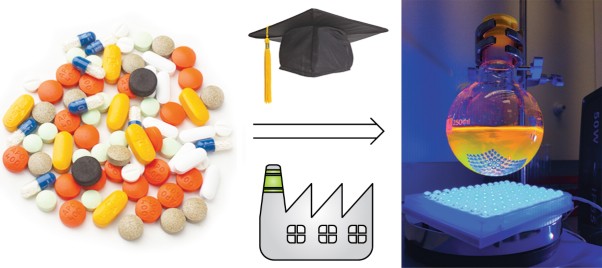 |
 |
Review Articles | |
 |
 |
 |
| Strategies for microbial synthesis of high-value phytochemicals pp395 - 404
Sijin Li, Yanran Li & Christina D. Smolke
doi:10.1038/s41557-018-0013-z
Phytochemicals exhibit great pharmaceutical importance despite their low abundance in nature. The microbial biosynthesis of complex phytochemicals offers one route to increase their availability and production. This Review discusses recent strategies to reconstruct plant biosynthetic pathways that have not been fully elucidated; enhance plant enzyme activity; and enhance overall reaction efficiency of multi-enzyme pathways. 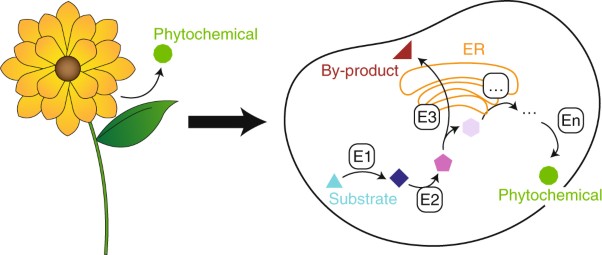 |
 |
| Advertisement |
 |
| npj Computational Materials is a new online only, fully open access journal dedicated to publishing the finest articles on materials by design and integrated computational and experimental materials research. |  | |
 |
| |
Articles | |
 |
 |
 |
| Ribosomal synthesis and folding of peptide-helical aromatic foldamer hybrids pp405 - 412
Joseph M. Rogers, Sunbum Kwon, Simon J. Dawson, Pradeep K. Mandal, Hiroaki Suga et al.
doi:10.1038/s41557-018-0007-x
The extent to which peptide synthesis by the ribosome can tolerate the inclusion of non-peptidic components is not clear. Yet such hybrids would expand the range of ribosomally synthesized structures. Now it has been shown that tRNAs acylated by aromatic foldamers can initiate the ribosomal synthesis of non-cyclic and cyclic foldamer-peptide hybrid molecules. The oligo-aryl segments contain folding information that can control peptide conformation in the hybrids. 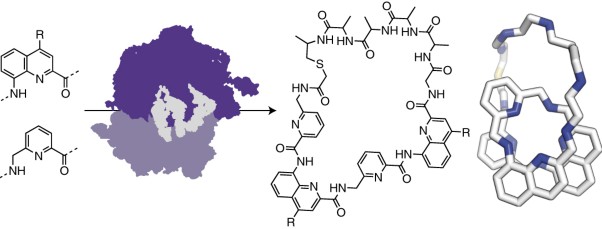 |
 |
 |
 |
| Hydroxide diffuses slower than hydronium in water because its solvated structure inhibits correlated proton transfer pp413 - 419
Mohan Chen, Lixin Zheng, Biswajit Santra, Hsin-Yu Ko, Robert A. DiStasio Jr et al.
doi:10.1038/s41557-018-0010-2
Even though the Grotthuss mechanism was proposed two centuries ago, it is still unclear why proton transfer via the hydroxide ion is slower than that via hydronium. Advanced ab initio molecular dynamics simulations now show that it is because proton transfer via hydroxide is less temporally correlated than transfer via hydronium. 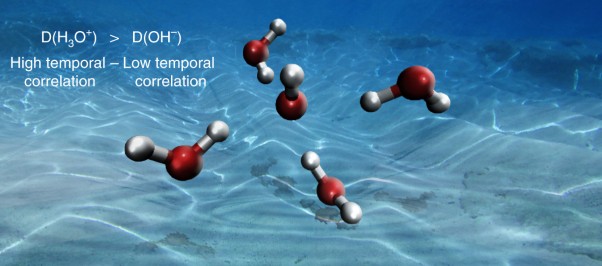 |
 |
 |
 |
| Evolution of sequence-defined highly functionalized nucleic acid polymers pp420 - 427
doi:10.1038/s41557-018-0008-9
A method to produce sequence-defined, diversely functionalized nucleic acid polymers that bind to proteins of biomedical interest has been developed. The method is based on a ligase-mediated, DNA-templated polymerization system and in vitro selection. The selected polymers are shown to bind their targets in a manner that is strongly dependent on specific side chains at certain polymer positions.  |
 |
 |
 |
| Experimental and computational evidence of halogen bonds involving astatine pp428 - 434
Ning Guo, Rémi Maurice, David Teze, Jérôme Graton, Julie Champion et al.
doi:10.1038/s41557-018-0011-1
Halogen bonding is known to get stronger with increasing halogen polarizability, but some trends of the periodic table break down for heavy elements owing to relativistic effects. Now, through distribution coefficient measurements and relativistic quantum mechanical calculations, AtI has been shown to form stronger halogen bonds than I2-meaning that astatine conforms to the trend. 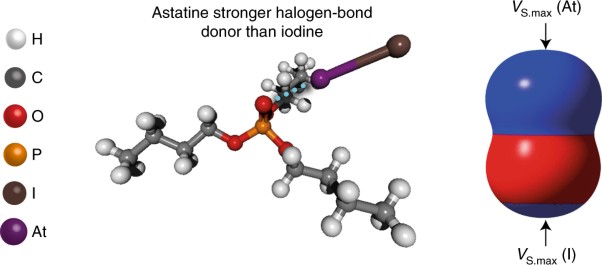 |
 |
 |
 |
| Scattering resonances in bimolecular collisions between NO radicals and H2 challenge the theoretical gold standard pp435 - 440
Sjoerd N. Vogels, Tijs Karman, Jacek Kłos, Matthieu Besemer, Jolijn Onvlee et al.
doi:10.1038/s41557-018-0001-3
Calculations at the theoretical gold standard generally yield accurate results for a variety of energy-transfer processes in molecular collisions. Using anti-seeding methods in a crossed-beam inelastic scattering experiment, a resonance structure is clearly resolved for NO-H2 collisions, pushing the required accuracy for theoretical potentials beyond the gold standard. 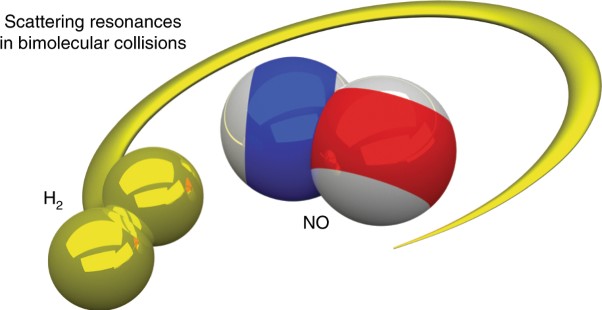 |
 |
 |
 |
| Versatile protein recognition by the encoded display of multiple chemical elements on a constant macrocyclic scaffold pp441 - 448
Yizhou Li, Roberto De Luca, Samuele Cazzamalli, Francesca Pretto, Davor Bajic et al.
doi:10.1038/s41557-018-0017-8
Encoded display of multiple chemical elements on a constant macrocyclic scaffold could mimick antibody–antigen recognition. A chemical library constructed using this approach enabled the identification of specific binders against a variety of protein targets, including difficult targets, such as TNF. 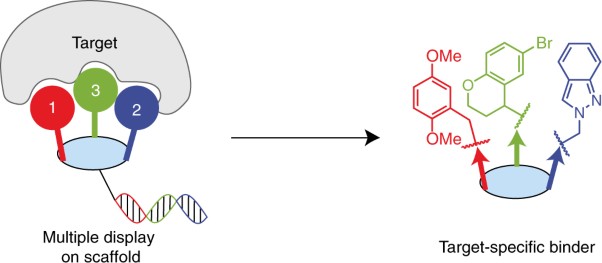 |
 |
 |
 |
| Evidence for a vibrational phase-dependent isotope effect on the photochemistry of vision pp449 - 455
C. Schnedermann, X. Yang, M. Liebel, K. M. Spillane, J. Lugtenburg et al.
doi:10.1038/s41557-018-0014-y
Isotope effects provide deep insight into mechanisms of chemical and biochemical processes. Now, it has been shown that the pattern of isotopic substitution of the isomerizing bond of the retinal chromophore in the visual pigment rhodopsin significantly alters the reaction quantum yield—revealing a vibrational phase-dependent isotope effect. 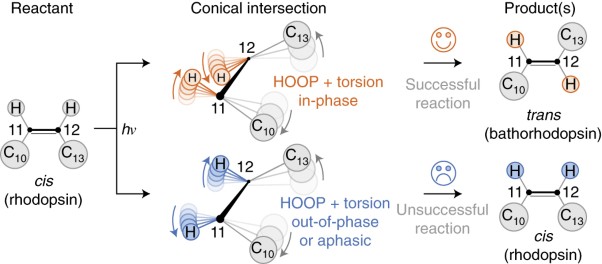 |
 |
 |
 |
| Crystal phase-based epitaxial growth of hybrid noble metal nanostructures on 4H/fcc Au nanowires pp456 - 461
Qipeng Lu, An-Liang Wang, Yue Gong, Wei Hao, Hongfei Cheng et al.
doi:10.1038/s41557-018-0012-0
Heterometallic nanomaterials in unusual crystal phases that are impossible to form in the bulk state can show interesting physical and chemical properties. Here, crystal-phase heterostructured 4H/fcc Au nanowires are used as seeds to epitaxially grow a variety of binary and ternary hybrid noble metal nanostructures on the phase boundary. 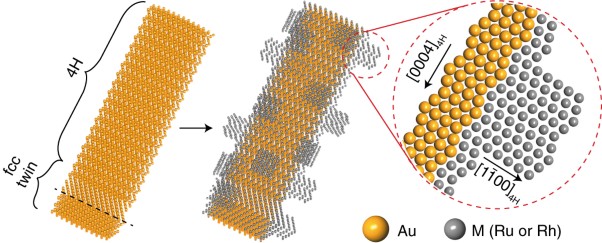 |
 |
 |
 |
| Chemical evolution of atmospheric organic carbon over multiple generations of oxidation pp462 - 468
Gabriel Isaacman-VanWertz, Paola Massoli, Rachel O'Brien, Christopher Lim, Jonathan P. Franklin et al.
doi:10.1038/s41557-018-0002-2
Nearly all organic carbon has now been quantified and characterized in a highly complex evolving atmospheric system, specifically, the multigenerational oxidation of α-pinene. It has been observed that initial addition of functional groups quickly gives way to fragmentation reactions, with organic carbon ultimately becoming sequestered in chemically resistant reservoirs: organic aerosols and long-lived gas-phase species. 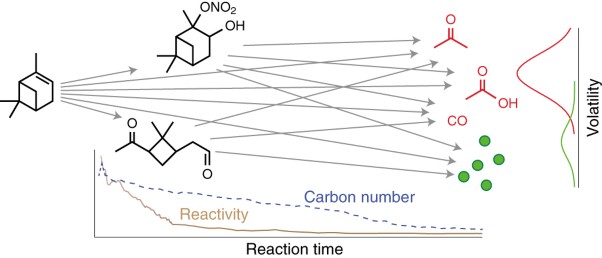 |
 |
 |
 |
| Observation of correlated excitations in bimolecular collisions pp469 - 473
Zhi Gao, Tijs Karman, Sjoerd N. Vogels, Matthieu Besemer, Ad van der Avoird et al.
doi:10.1038/s41557-018-0004-0
Collisions between atoms and molecules are largely understood; however, our understanding of collisions between two molecules is lacking because they are significantly harder to study, Now, correlated rotational excitations have been observed in inelastic collisions between NO and O2 molecules. It is shown that the energy-gap law that governs atom–molecule collisions does not generally apply to bimolecular excitation processes. 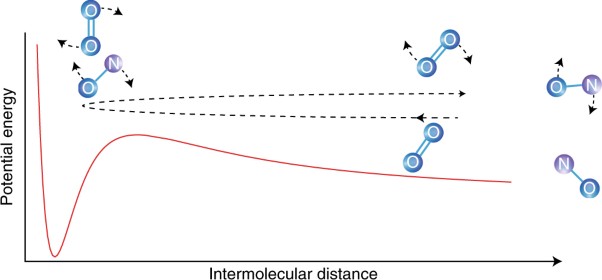 |
 |
 |
 |
| Dynamic protein assembly by programmable DNA strand displacement pp474 - 481
Rebecca P. Chen, Daniel Blackstock, Qing Sun & Wilfred Chen
doi:10.1038/s41557-018-0016-9
The construction of dynamic protein-DNA nano-assemblies suitable for modulating protein proximities and activities has now been demonstrated. This approach uses DNA strand displacement and can enable control of enzyme activity to be programmed using logic gates. As a demonstration, a split enzyme capable of activating a prodrug is triggered is by cancer-specific miRNAs. 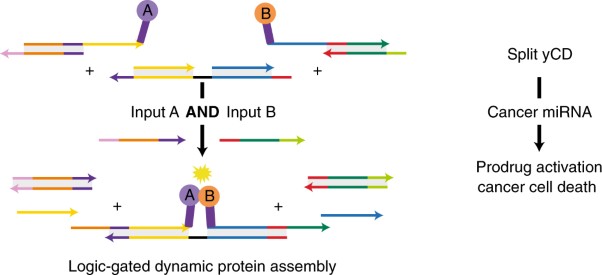 |
 |
| Advertisement |
 |
npj Science of Food is a new open access journal that is now open for submissions. The journal aims to understand how processing influences biological functions of food in hope to support and nucleate maturation of these areas of research.
Sign up for article e-alerts >>> |  | |
 |
| |
 |
 |
In Your Element | |
 |
 |
 |
| Hidden hassium p482
Michael A. Tarselli
doi:10.1038/s41557-018-0037-4
From its scarcity to political intrigue over naming conventions, element 108's story describes how international cooperation overcame the limits of nuclear science, says Michael Tarselli. |
 |
 |  |  |  |  |  | Natureevents is a fully searchable, multi-disciplinary database designed to maximise exposure for events organisers. The contents of the Natureevents Directory are now live. The digital version is available here.
Find the latest scientific conferences, courses, meetings and symposia on natureevents.com. For event advertising opportunities across the Nature Publishing Group portfolio please contact natureevents@nature.com |  |  |  |  |  | |
 |


1 comment:
Many studies require the use of peptides with more than 50 to 150 amino acids. Researches have also shown that synthetic long peptide-binding adjuvants have been widely used in cancer therapeutic vaccine research. Long Peptides Synthesis
Post a Comment